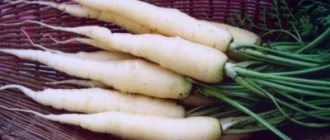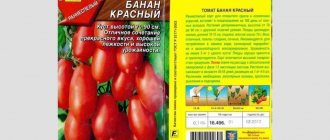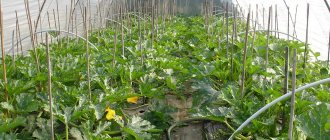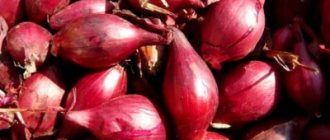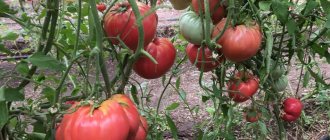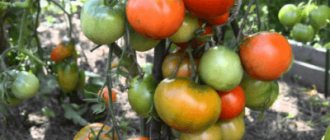Vegetable growing » Carrots
1
1057
Article rating
Kira Stoletova
Every gardener has his own favorite varieties of vegetables. Preference is given to high-yielding species that do not require special care. Rote Riesen carrots, which are distinguished by their characteristics among other root crops, attract particular attention from gardeners.
Carrot Rothe Risen
Characteristics and description of the Red Giant variety
The carrot variety Red Giant is a translation from the German name ROTE RIESEN, a variety of German breeders.
- Appearance. The root crop is a conical, elongated shape that tapers to a pointed tip. The length of the carrot is 22-24 cm, thickness 4-6 cm. The root vegetable itself is orange-red in color and has a medium-sized core of the same color. The leaves of this carrot are very long, medium-dissected and dark green in color. The variety is not prone to shooting arrows and does not crack.
- Which variety does it belong to? Red Giant belongs to the Flakke (Valeria) variety. These are late-ripening carrots, suitable for long-term storage (read about late-ripening, early-ripening and mid-ripening varieties of carrots in a separate article).
- Amounts of fructose and beta-carotene. The root vegetable contains in 100 g:
- fructose – 7-8.8%;
- carotene – 10-12 mg.
- Sowing time. In spring, carrots are sown in April-May at a minimum soil temperature of +10 degrees Celsius. Pre-winter sowing is carried out in the fall at a temperature of +5 degrees Celsius. The germination rate of seeds of this variety is 70%. Germination period is 5-25 days.
- Average weight of 1 root vegetable. Its average weight is 150-180 g, and can reach up to 200 g.
- What is the yield from 1 hectare. The Red Giant carrot has a high yield of 300-500 c/ha.
- Purpose of the variety and keeping quality. This carrot variety can be used:
- fresh;
for salads;
- juice preparation;
- for freezing in grated form.
- Growing regions. The root crop is grown in most regions of Russia.
- Where is it recommended to grow? The variety is recommended by breeders for cultivation in the ground in the open air.
- Resistance to diseases and pests. It is highly resistant to diseases and pests.
- Maturing period. The ripening period ranges from 120 to 160 days depending on weather conditions, soil composition and moisture.
- What types of soil does he prefer? The Red Giant prefers loam and sandy loam soil. Slightly acidic soils are well suited.
- Frost resistance and transportability. The variety has excellent frost resistance and good transportability.
- Manufacturability of the variety for farmers and peasants. The Red Giant carrot variety is highly adaptable for cultivation by farmers and peasants. Modern technologies for cultivating this crop, harvesting and storing the crop have been developed. Convenient to clean and process for culinary purposes.
Has excellent keeping quality. If stored properly, the root crop can be used until the end of spring.
Rules for growing and care
To grow Rote Riesen, choose an area with sandy loam, slightly loamy soil with neutral acidity.
Attention! Do not plant the crop on heavy, clay soils. In such soils, root crops are deformed, grow slowly and develop poorly.
If there is such soil on the site, sand and neutralized peat (3 kg/m²) are added during deep digging. The soil should drain well and not retain moisture.
They begin to prepare the site in the fall, digging it up with a shovel, breaking up rough lumps, removing stones and plant debris. When digging, mineral fertilizers are added to the soil: urea - 20 g/m², superphosphate - 15 g/m², potassium sulfate - 25 g/m². From organic matter, wood ash, humus, and compost are used. Before spring planting, the soil is loosened again and organic matter is added.
Dates and place for landing
For cultivation, choose a place illuminated by the sun, not obscured by trees. The site should not be in a lowland, as melt and rainwater accumulate there, which leads to the formation of rot.
The best crop predecessors are potatoes, tomatoes, cucumbers, legumes, and onions.
Sowing work is carried out in late April - early May. Sowing carrots begins only after the soil has warmed to a depth of 10 cm to +8...+10°C. Since the variety is frost-resistant, some farmers practice sowing seeds at +6°C.
The Rote Riesen variety is also suitable for winter cultivation. Sowing is carried out at the end of October, before the temperature drops below +5°C. The seeds are planted to a depth of 2-2.5 cm. The beds are mulched with peat and sawdust.
When planting before winter, Rote Riesen carrots are harvested in mid-August.
Sowing technology
For carrots, make shallow beds at a distance of 25-30 cm from each other. Before planting, water them with warm, settled water and wait until the liquid is completely absorbed. To make planting easier, seeds are first glued onto thin paper.
The seeds are placed to a depth of 2-2.5 cm, leaving a gap of 5-6 cm, and covered with soil, pressing lightly with your hand. Do not water the beds immediately after sowing, as this will cause the formation of a soil crust and make it difficult for seeds to germinate.
Care after sowing
After sowing, the crop requires regular care, consisting of thinning seedlings, timely removal of weeds, loosening the soil, watering and fertilizing.
Watering
After the emergence of seedlings, the beds are moistened every 3 days by sprinkling, so as not to wash the seeds from the soil with a stream of water. Watering is gradually reduced to once every 6-7 days. For uniform growth of vegetables, the soil should be slightly moist. As the root crops grow, increase the volume of liquid when watering.
Important! Watering should not be superficial; the soil should be moistened to a depth equal to the length of the carrot.
With insufficient watering, root crops wither and begin to taste bitter. Excessive watering causes cracks in carrots. In dry weather, Rote Riesen carrots require daily watering with a small amount of water.
Watering is stopped 20-25 days before harvest.
Feeding
For the growth and development of the crop, fertilizing is used. The first is carried out 2 weeks after emergence. Nitrogen fertilizers are applied: 15 g of urea is diluted with 10 liters of water.
After 20 days, fertilize a second time. At this time, root crops are being formed, and the crop requires potassium and phosphorus. For irrigation, prepare the following composition: 25 g of superphosphate, 20 g of potassium nitrate, 10 liters of water. Nitrogen fertilizers are no longer used, as they will lead to rapid growth of tops.
After another 3 weeks, 3-4 g of boric acid and 2 g of potassium permanganate, diluted in 10 liters of water, are added to the soil. These elements are necessary for better filling of root vegetables. Mineral fertilizers alternate with organic matter. The beds are watered with an infusion of wood ash: 250 g of ash are infused in 10 liters of water for 24 hours.
Attention! Carrots do not tolerate fresh organic fertilizers (cow manure, bird droppings). These fertilizers impart bitterness to root vegetables.
Weed control
Weeds appear in the beds faster than carrot shoots sprout. For active growth, they take nutrients from the soil, thereby inhibiting the development of carrots. Therefore, great attention is paid to weed removal.
Remove weeds from the soil carefully so as not to damage the root system of young seedlings.
Thinning
For normal development of root crops, thinning is carried out. The first time is after the formation of two true leaves. A distance of 2-3 cm is left between the seedlings. The second time the seedlings are thinned out after the formation of two pairs of true leaves, increasing the gap between the seedlings to 5-6 cm.
During thinning, the soil is loosened, removing the soil crust. Simultaneously with loosening, the rows are earthed up to prevent the carrot tops protruding from the soil from turning green.
Prevention of diseases and pests
The carrot variety Rote Risen is characterized by resistance to crop diseases, but if the rules of agricultural technology are violated, when plantings are thickened and sown in soil untreated from pathogenic fungi, the crop is affected by various fungal diseases.
If crop rotation rules are violated or prevention is not carried out, pest attacks are possible.
Fomoz (dry rot)
An infectious fungal disease that occurs at all stages of plant development and during storage. The disease begins with the appearance of small depressed gray spots on the tip of the carrot.
The spots gradually become soft and acquire a brown tint. A void is formed in the root crop. To prevent the disease, potassium fertilizers are added to the soil. Before planting, the beds are treated with a 1% solution of Bordeaux mixture.
Alternaria (black rot)
Fungal infection. On young shoots the stem begins to turn black. On adult plants, the leaves of the tops curl, turn yellow, and dry out. The stems become soft and bend towards the ground.
Areas of black rot appear on root crops. At the first signs of disease, the plantings are sprayed with the preparation “Rovral” (1 g diluted in 1 liter of water).
Bacteriosis
The fungal infection begins on the edges of the lower leaves in the form of yellow spots that darken with magnification. Light gray or yellowish drops of liquid appear at the base of the petioles.
The stems become covered with brown spots, and brown depressed areas and ulcers form on the roots. The plant gives off an unpleasant odor. At the initial stage of the disease, plants are sprayed with the preparation “HOM”.
carrot fly
The insect overwinters in the soil. Its presence is indicated by a bronze tint on the leaves. The leaves curl and fall off. Root vegetables become unsuitable for consumption.
To combat flies, the drugs “Decis Profi” and “Aktellik” are used. For prevention, timely loosen the soil and remove weeds. The tops are pollinated with tobacco dust and ash.
psyllid
A small insect whose females lay eggs on carrot leaves. The larvae feed on the sap of the leaves, causing them to dry out. The tops are treated with tobacco dust and sprayed with a solution of laundry soap.
Wireworm
Click beetle larva. The pest feeds on root crops, eating the pulp. Damaged vegetables should not be eaten. To destroy the pest, fertilizers containing ammonia are applied to the soil, and the soil is limed before planting. The drugs “Bazudin” and “Aktara” are used.
Advantages and disadvantages
The advantages of the Red Giant carrot variety are:
- high productivity;
- sweet and juicy;
- possibility of long-term storage while maintaining taste;
- excellent keeping quality;
- the variety is resistant to diseases and pests;
- versatility in use.
The disadvantages are:
- long ripening of root crops;
- demanding attitude to moisture;
- low seed germination.
What are the good things about Rote Riesen carrots and what are their disadvantages? Reviews
Summer residents who have already appreciated the benefits of the Red Giant note that this carrot:
- very tasty, sweet and juicy. It makes good juice;
- germinates well, even when sown before winter;
- perfectly stored in the cellar, maintaining freshness;
- gives a good harvest;
- has very large sizes. Root crops are even and neat;
- It does not require special care;
- universal in use.
At the same time, there are also not very positive opinions about the Rote Riesen variety.
Gardeners disappointed with these carrots say:
16 excellent varieties of plums for the Moscow region
- germination rate may be far from 100%;
- Root crops take a long time to ripen;
- the size of carrots is comparable to the harvest of other varieties, and if it exceeds them, then not by much;
- Red giant is more suitable for storage in the basement and consumption in winter and early spring. For the summer-autumn period, you can choose other, more tasty and early varieties.
Advice. In reviews, summer residents usually note which company’s seeds they purchased. Sometimes this information can be found out from a photo of the packaging - people often supplement their written opinions with it. Read which manufacturer gardeners trust more than others. The seeds of this company are unlikely to disappoint you if they have already gained a positive reputation among other gardeners.
Growing
The optimal temperature at which the seeds of the Red Giant will sprout is +10 degrees Celsius.
For sowing, it is best to choose sandy loam soil with low acidity. Before planting, the area is fertilized with humus. The variety is demanding on soil looseness; it must be carefully prepared. A feature of sowing root crops is the increased distance between seeds - 4-5 cm.
Caring for the Red Giant involves regular watering. 14 days after the sprouts appear, the first thinning is done. The second is done when the diameter of the young carrots becomes about 2 cm.
Growing the variety
The Red Giant variety prefers a sunny place.
Sandy loam or light loamy soil with a deep arable layer that is capable of permeating moisture is suitable. To give the soil such features, add a little sand. Carrots grow well in areas where cabbage, onions, tomatoes, early potatoes, and cucumbers were grown last year.
You should start preparing the land in the fall: dig it up, remove old roots and stones. You need to repeat the same procedure in the spring before planting. Next, the soil is fertilized with a solution of nitrate or urea. It is recommended not to use organic fertilizer in the form of manure, because it provokes distortion of the shape of root crops.
Sowing is done in late April - early May, when the soil can warm up to 10°C. Some sow carrots at 4°C, since the variety is known for its resistance to cold. For better germination, seeds are placed on damp gauze in a cool place for a week.
Sweet and juicy carrots
The beds are prepared shallow, on average 2-3 cm, at a distance of 20-30 cm from each other. Water them with a small amount of warm water, which should settle. When the moisture is absorbed, sow the seeds at a distance of 4-7 cm. Sometimes, to maintain the gap, they are glued to adhesive tape in advance, which will not prevent the sprouts from sprouting in the future. Fill the beds with soil, but do not water them - this can cause crust formation and make it difficult for seedlings to germinate.
Features of care
- For active carrot growth, weeds are regularly removed as they appear. Sometimes this action is carried out even before germination of the seedlings. Harmful plants remaining in the garden can damage root crops, taking away all the beneficial substances from the soil.
- Wanting to get large fruits, thin out the rows of carrots after the first pair of true leaves appear. Maintain a distance not exceeding 4 cm. The second thinning is carried out when there are two pairs of true leaves, increasing the perimeter by 2 times.
- Loosen the soil to allow air and water to reach the plant's root system. In addition, the crust formed on the surface of the soil provokes the curvature of root crops even while maintaining a large mass. Hill up the rows of carrots after the rain to prevent the peeking out tops from turning green due to subsidence of the soil.
Watering and fertilizing
It is better to water Rote Riesen every day, especially during drought, but in small quantities. The depth of moisture is directly related to the size of the root crops. Insufficient water will cause the carrots to become bitter and lethargic, and overwatering will cause the roots to crack.
Nutrients should be added to maintain the growth and development of the Red Giant twice during the growing season. The first feeding is carried out 3-4 weeks after the appearance of sprouts, the second – after 2 months. For better absorption, fertilizers are applied in liquid form, diluted in water. To do this, use one of the ingredients:
- two glasses of wood ash;
- 1 tbsp. nitrophoska;
- 20 g of potassium nitrate, 15 g of urea, 15 g of double superphosphate.
Diseases and pests
The Red Giant is amazed:
- Carrot fly. Its larvae eat roots and leaves, and the plant dies. To avoid this, it is necessary to promptly thin out the seedlings and remove weeds, and treat the plants with insecticides.
- Slugs. In very wet weather, slugs can develop and chew holes in root crops.
Among the diseases, the Red Giant is susceptible to Phomasis. The disease affects plants at the end of the growing season. Oblong gray-brown spots appear on the leaves and petioles. Phoma actively develops on fruits and continues its activity during storage. Dark depressions form on them.
Phomasis is almost impossible to cure. All affected plants must be removed. To prevent the disease, it is necessary to apply phosphorus-potassium fertilizers before planting.
Problems during cultivation and ways to solve them
No matter how much we would like it, carrots, like any other plant on Earth, sometimes do not grow as we would like. The development of carrots is influenced not only by garden pests, but also by the growing region, the quality of the soil and care.
When growing the Red Giant, the following problems may arise:
- Unfriendly and low germination rate. The cause may be excessively dense soil. To eliminate this cause, you need to additionally loosen the soil and add sawdust and peat.
- Low sugar content. The cause may be highly acidified soil. Liming is necessary for deoxidation.
Planting carrot seeds
Before planting seeds, it is necessary to assess the soil moisture. If it is dry, you need to moisturize it. Furrows are made in the bed 15 cm apart and 2 cm deep.
There are several planting methods:
- Small seeds are scattered by hand along the grooves.
- Soaked and sprouted seeds are planted more carefully.
- Seeds in the form of dragees.
- From a syringe. Make jelly from flour, add nutrients, cool, and add seeds. Using a syringe, sow evenly into the furrows.
- Seeds on strips of paper. This method will avoid further thinning.
Then the top is covered with earth and compacted by hand or a special board. The carrots are planted. In the future, she requires systematic care.
Similar species to Rote Riesen
In Russia, carrot varieties are also used that are similar in their taste, ripening time, cultivation technology, frost resistance, and keeping quality, like the Red Giant. These are varieties such as:
- Berlicum Royal;
- Volzhskaya 30;
- Emperor;
- Queen of Autumn;
- Incomparable.
We suggest studying information about some other popular varieties of carrots. These include Touchon, Chantanay, Red Cor, Dordogne, Samson, Karotel and September.
Red Giant is still a new carrot variety , but thanks to its remarkable properties it can easily compete with other varieties. Considering its manufacturability and high yield, it will be readily used in farms and peasant farmsteads.
Rules of care
- Moderate daily watering to maintain constant soil moisture to prevent fruit cracking.
- Loosening the soil for better air and moisture permeability and preventing the development of weeds.
- Hilling up root crops so that the exposed tops do not turn green due to soil subsidence after watering or rain.
- Fertilizing with mineral fertilizers, especially during the growing season and when growing root crops.
Thus, caring for the plant does not require much effort, which is undoubtedly another advantage of this variety. However, to obtain a high yield of large and sweet carrots, it is strongly recommended to provide the plant with all the necessary conditions for comfortable growth.
Gardeners and summer residents fell in love with the “Red Giant” (“Rote Risen”) variety for its large fruits, the juiciness and taste of carrots, and the possibility of long-term storage in winter. And if you maintain the right temperature and humidity, you can enjoy carrots until spring!

